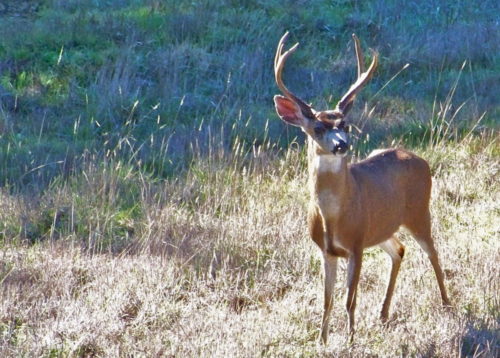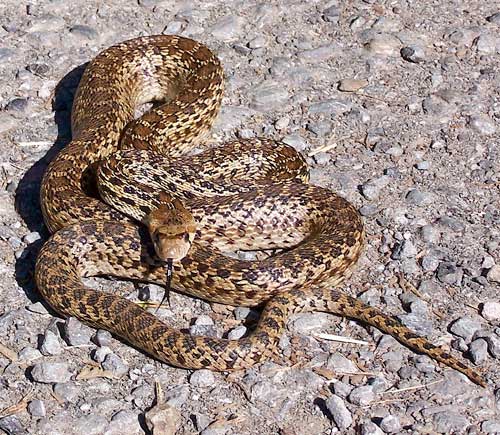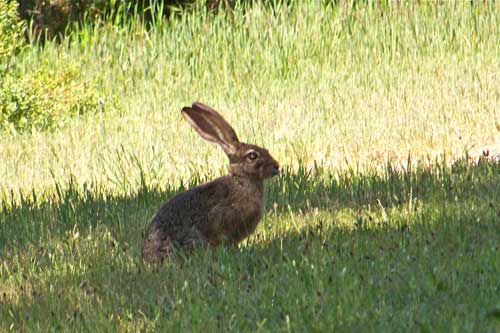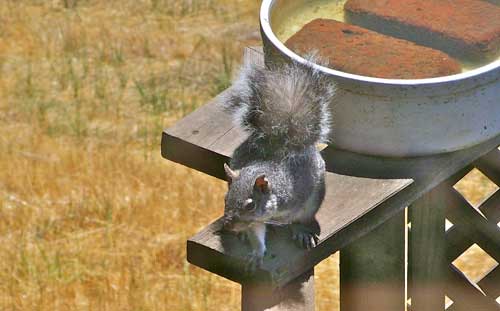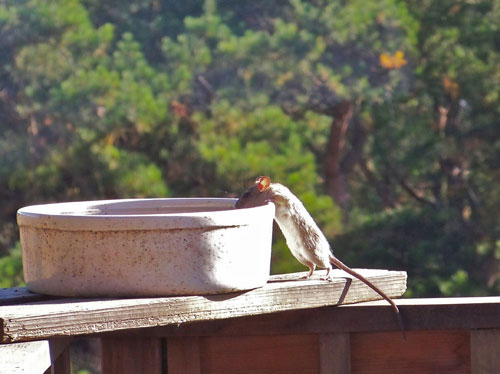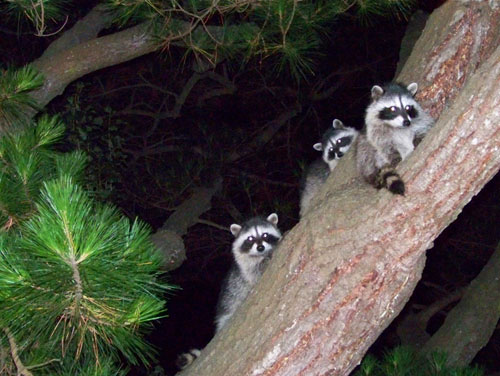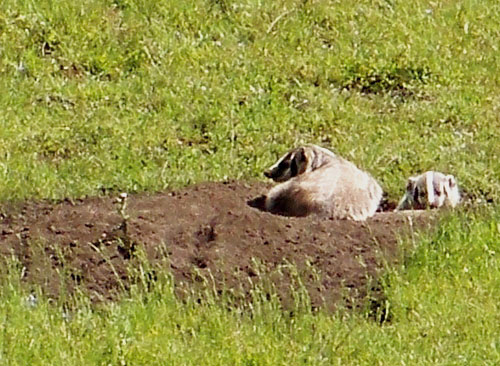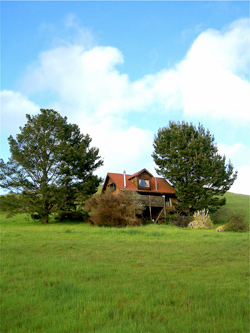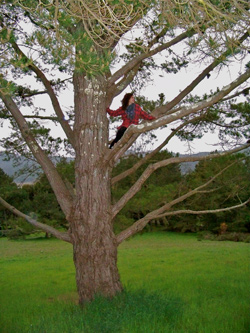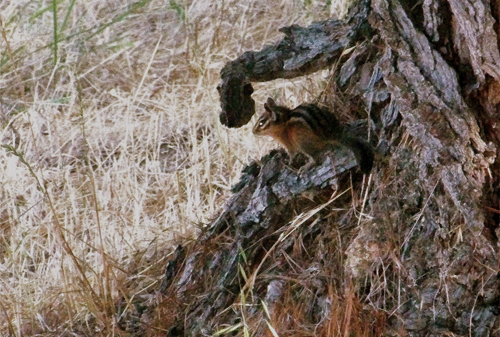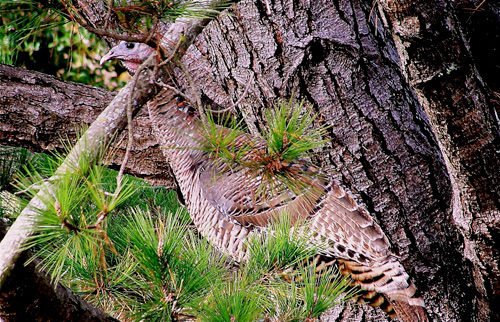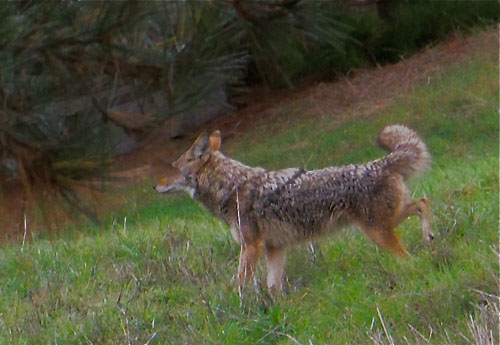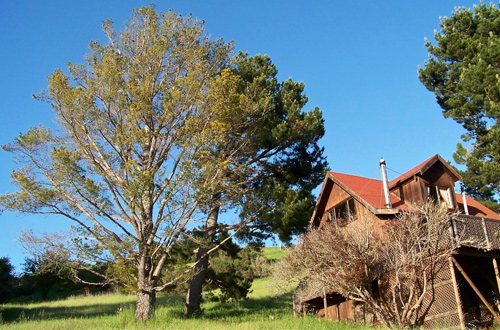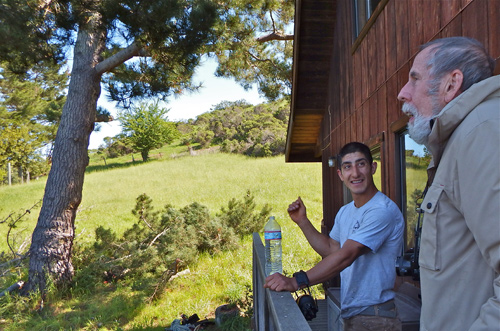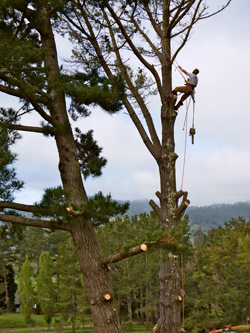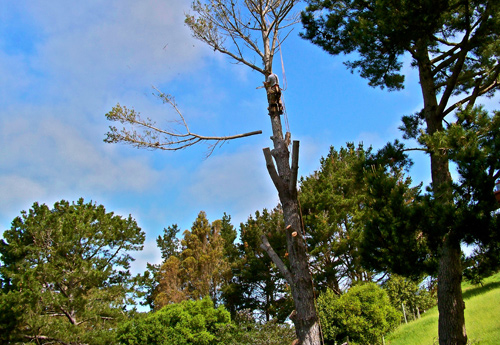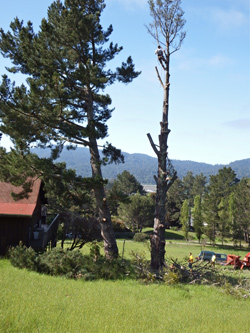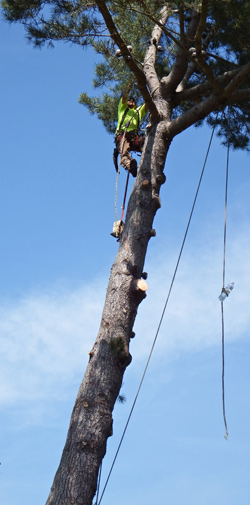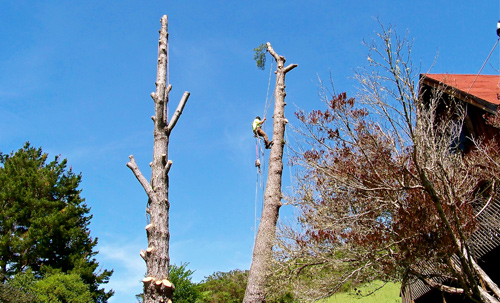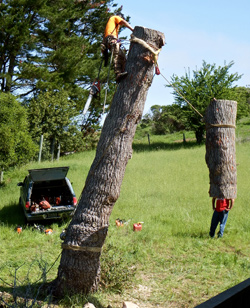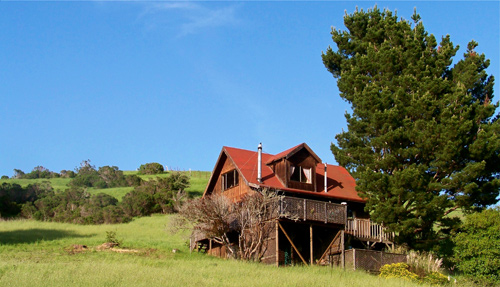Entries tagged with “chipmunk”.
Did you find what you wanted?
Fri 27 Aug 2021
Posted by DavidMitchell under Uncategorized
Comments Off on Where have all the badgers gone?
To get away from the present grim realities of human society, as were discussed here last week, this week we’ll take a few looks at the fascinating realities of the non-human society that’s seen around Mitchell cabin.

This past week, my wife Lynn spotted a bobcat in a persimmon tree next to our front steps. It’s not that we live in a literal zoo. Bobcats are fairly common here and elsewhere in Point Reyes Station.

Pouncing. A bobcat pounces on a gopher not far from our deck.
Coyotes. Predators even more noticeable are the coyotes. This one is looking at my parked car. Most nights the coyotes on this hill howl to establish territory. Contrary to widespread opinion, coyotes do not howl to announce a kill, for that would invite other coyotes to steal the prey.

Grey foxes are another set of predators we see fairly often. These are just outside the kitchen door scouring up the last of the kibble I had earlier given to some raccoons.

Badgers. Where did they go? When I first moved to this hill 45 years ago, there were a number of badger burrows. I spotted this pair one morning when I looked up from the breakfast table. They were easily visible on a nearby hillside. From their burrow’s entrance, the sow and cub were keeping an eye on the world. New badger holes used to be annual events here, but I haven’t seen a new one in five years or more.

Chipmunks are totally absent from our hill. This one apparently wandered over from Inverness Ridge a decade ago, but it didn’t stick around.

Gray squirrels can be a nuisance, and controlling them is an annual topic for discussion around here. The squirrels like to eat the cambium layer just under the bark on pines, often killing the ends of the limbs they munch on.
 The possums we see around here are Virginia Opossums, which are native to North America. Their lifespan is typically around four years. Possums are marsupials with counterparts found in Central and South America, New Zealand, and Australia.
The possums we see around here are Virginia Opossums, which are native to North America. Their lifespan is typically around four years. Possums are marsupials with counterparts found in Central and South America, New Zealand, and Australia.
To quote Wikipedia: “A marsupial is a mammal that raises its newborn offspring inside an external pouch at the front or underside of their bodies. In contrast, a placental is a mammal that completes embryo development inside the mother, nourished by an organ called the placenta.”

A jack rabbit in our backyard. As noted here before: “Jackrabbits were named for their ears, which initially caused some people to refer to them as ‘jackass rabbits.’ The writer Mark Twain brought this name to fame by using it in his book of western adventure, Roughing It. The name was later shortened to jackrabbit.”
Raccoons and skunks end up eating together so often they get along with each other fairly well.

A blacktail buck makes his daily appearance grazing beside Mitchell cabin. Of all the creatures I see, the bucks seem to have the most regal bearing.
Mon 5 Jan 2015
Posted by DavidMitchell under West Marin nature, Wildlife
Comments Off on A gallery of the critters around Mitchell cabin
 Around the first of the year I sometimes post a roundup of the creatures that have shown up around Mitchell cabin.
Around the first of the year I sometimes post a roundup of the creatures that have shown up around Mitchell cabin.
This year I’m doing it again, starting with a butterfly and dragonfly followed by a variety of larger critters.
This exhibit ends with a coyote, a bobcat, two badgers, and two deer rubbing noses.
Regular readers of this blog will recognize some of these photos from past postings.
Here a buckeye butterfly rests on a chrysanthemum that’s growing in a flowerpot on the deck. ___________________________________________________________________

A dragonfly pauses on the twig of a tree that’s next to the deck. Dragonflies can easily be distinguished from damselflies because when they are at rest they leave their wings extended while damselflies close their wings over their bodies when at rest. __________________________________________________________________
 A Pacific tree frog on a bamboo shoot near our hot tub.
A Pacific tree frog on a bamboo shoot near our hot tub.
Some people call them Pacific chorus frogs. During the winter, their main mating season, males make their way to water and then charm females to the water with a chorus of chirping.
________________________________________________________________

Gopher snakes are not poisonous, but they mimic rattlesnakes, coiling up and wagging their tongues when threatened. This one was near the foot of our driveway.

A jackrabbit in the field outside our kitchen window pauses to look around .

This is the only chipmunk I’ve ever seen around Mitchell cabin. I’m just glad I had my camera nearby when it showed up.

A Western gray squirrel basks in the sun after taking a drink from our birdbath.

A roof rat takes a drink from the birdbath. These rats originated in southern Asia, and you’ll recall it was their fleas that spread the Black Death throughout Europe in the 14th Century, killing roughly half the people.

This cute possum used to be a regular nighttime visitor, but so many raccoons have been hanging around the cabin in the evening that we seldom see any possums these days.

Three raccoons in a tree beside Mitchell cabin. ______________________________________________________________
 A gray fox enjoys the sun on our deck.
A gray fox enjoys the sun on our deck.
_________________________________________________________________

A coyote watches me park my car as I arrive back home.

A bobcat hunts outside our kitchen window.

A mother badger and her kit eye the world from their sett, as badger dens are called.

Two deer touch noses as a herd of six blacktails graze downhill from Mitchell cabin.
For reasons of space, no birds are included in this posting. Look for a gallery of our fine feathered friends in a week or two.
Tags: badgers, blacktail deer, bobcat, Buckeye butterfly, chipmunk, coyote, damselfly, dragonfly, gopher snake, gray fox, jackrabbit, Pacific tree frog, possum, raccoons, racoons, roof rat, Western gray squirrel
Mon 14 Apr 2014
Posted by DavidMitchell under West Marin nature
[2] Comments

For years, this was my view of Mitchell cabin as I drove up my driveway.
The cabin was framed by a large Monterey pine on the right and two others on the left.
It was an ideal setting for a cabin, I’d always thought.
My former wife Cathy and I built the cabin in the winter of 1976-77, and we planted the pines soon after moving in.
_____________________________________________________________
 The pines on the west side of the house have long been perches for all manner of birds and have provided refugee for many four-footed creatures, as well.
The pines on the west side of the house have long been perches for all manner of birds and have provided refugee for many four-footed creatures, as well.
They’ve also been people-friendly. A year ago they inspired my stepdaughter Shaili (left), who was visiting from Minnesota, to try her hand at climbing.
________________________________________________________________

The only chipmunk I’ve ever seen around Mitchell cabin showed up one summer morning at the base of one of the pines. _________________________________________________________________

Wild turkeys have become accustomed to using the pines for lookout posts.________________________________________________________________

Here a bashful possum peeks around one of the pines. _________________________________________________________________

And here a coyote prowls underneath the same trees. ________________________________________________________________

Tragically, this stand of pines became doomed. The nearer tree died in the drought, and the further tree had begun to lean precipitously over the cabin. With great reluctance, I called Nick Whitney’s Pacific Slope tree service to cut the pines down and haul away any sad reminders of them. ________________________________________________________________

The pines had become so much a part of my home that I remembered how I felt when I had to take a sick, old dog to the vet to be put down. But there was no avoiding it, and Monday morning, the Pacific Slope crew showed up and got right to work. Here climber Ignacio Franco (left) listens to my lament. (Photo by Lynn Axelrod) ______________________________________________________________
 Despite the sadness of the occasion, Lynn and I were fascinated by the almost-gymnastic feats of Ignacio (seen here) and his brother José as they climbed the trees. (Photo by Lynn Axelrod)
Despite the sadness of the occasion, Lynn and I were fascinated by the almost-gymnastic feats of Ignacio (seen here) and his brother José as they climbed the trees. (Photo by Lynn Axelrod)
________________________________________________________________

A large limb comes floating down after Ignacio cuts it loose with a chainsaw. (Photo by Lynn Axelrod) ________________________________________________________________
 The limbs, pine needles, and cones were ground up in the orange chipper at right and then hauled away.
The limbs, pine needles, and cones were ground up in the orange chipper at right and then hauled away.
Here José Luis Franco, better known as Pepe, (in light-colored shirt) feeds the chipper while David Antonio Lopez (in yellow shirt) drags limbs over.
Ignacio, meanwhile, prepares to cut the top off the dead tree. (Photo by Lynn Axelrod)
_____________________________________________________________
 Pepe cuts a large limb off the top of the leaning pine. (Photo by Lynn Axelrod)
Pepe cuts a large limb off the top of the leaning pine. (Photo by Lynn Axelrod)
_______________________________________________________________
 A man can work up a thirst climbing to the top of a tree and then sawing off heavy limbs, so Pepe took a moment for a drink of water.
A man can work up a thirst climbing to the top of a tree and then sawing off heavy limbs, so Pepe took a moment for a drink of water.
Hoisting the bottle from ground level was his brother Ignacio, who used a block and tackle already in place for lowering cut limbs. (Photo by Lynn Axelrod)
_____________________________________________________________

Ignacio (left) uses a pulley to lower part of a limb that Pepe has cut while David drags off another. The limbs were too close to the house to be simply dropped. (Photo by Lynn Axelrod) ________________________________________________________________

As Pepe descends at the end of the day, these skeletons were all that remained of what had once been a familiar stand of Monterey pines. Tomorrow morning, the Pacific Slope crew will be back, and these too will disappear. (Photo by Lynn Axelrod) _______________________________________________________________
 Late-breaking news: Pepe, Ignacio, and David returned Tuesday as scheduled and finished their logging.
Late-breaking news: Pepe, Ignacio, and David returned Tuesday as scheduled and finished their logging.
Here Pepe appears to be dropping a section of trunk on David’s head, but David is tough, and the impact didn’t faze him. Perhaps because he was actually standing a safe distance away. (Photo by Lynn Axelrod) ________________________________________________________________

Mitchell cabin has survived, but to my eye, its west side now looks starkly naked. For the sake of decency, Lynn and I will soon adorn it with something floral, but for the moment we’re just pining for a couple of old friends.
Tue 8 Jan 2013
From a butterfly to a pair of badgers, from a newt and a salamander to a bobcat and a coyote, this posting is a collection of some of my favorites from among the photos I’ve taken of wildlife around Mitchell cabin.

A Buckeye butterfly atop a chrysanthemum on my deck.

Closeup of an amphibian, an arboreal salamander.

Lying low, another amphibian.
A Pacific tree frog’s color depends on where it is at the moment. Unlike chameleons, whose colors change to match background colors, tree frogs’ colors change (between brown and green) depending on how dry or moist their surroundings are.

A poisonous amphibian.
The skin of a California newt such as this secretes a neurotoxin, tetrodotoxin, that is hundreds of times more toxic than cyanide.

A macho reptile.
Male Western fence lizards do pushups to intimidate other males. In the process they reveal their blue undersides, which is why they’re sometimes called Blue-bellies.

A colorful but seldom seen reptile.
I found this Pacific ring-necked snake in a rotten log while splitting firewood. The snake eats very small creatures, tadpoles, insects, and especially salamanders. It has just enough venom to immobilize them but is not dangerous to humans.

A beady-eyed garter snake warms itself in the sun on my driveway.
Garter snakes are the most-common genus of reptile in North America. Although they are venomous, their venom is too mild to harm humans. However, when they’re disturbed, garter snakes emit a foul-smelling secretion from a gland near their anus.
Common garter snakes come in innumerable variations and are found in fields, forests and wetlands nationwide. Like this snake, adults average about four feet in length. In West Marin, their diet typically consists of tadpoles, slugs, and earthworms. But unlike other snakes, they don’t eat insects. When first born, the snakes are prey for bullfrogs. Hawks and foxes eat adults.

Gopher snakes are non-venomous although they don’t want you to know it.
“When disturbed, the gopher snake will rise to a striking position, flatten its head into a triangular shape, hiss loudly and shake its tail at the intruder,” the Arizona-Sonora Desert Museum website notes. “These defensive behaviors, along with its body markings, frequently cause the gopher snake to be mistaken for a rattlesnake.”

Golden-crowned sparrow disguised as a stained-glass window.

Heading for a drink at the birdbath on Mitchell cabin’s deck, a crow hops over a second crow, which stays put at their birdseed buffet.

A great blue heron hunting gophers in my field.

Chipmunks visit Mitchell cabin only occasionally, so I felt lucky to snap this photo of one.

A Western gray squirrel as seen from my bedroom window.
Every morning the ground around Mitchell cabin is littered with the freshly cut tips of pine branches because of this squirrel and his clan. Squirrels like to feed on pine trees’ cambium layer, which is immediately under the bark, and in the process they gnaw off twigs.

Trying not to be noticed.
West Marin’s large jackrabbits, which some people call black-tailed hares, are often seen in the late afternoon and evening around Mitchell cabin. To avoid catching the eye of predators, jackrabbits typically sit motionless unless the danger comes too close. Then they suddenly spring away, making sharp, evasive turns as they flee.

A gray fox on Mitchell cabin’s deck.

Young raccoons retreat to a tree when they feel threatened by other animals.

A blacktail doe nurses one of her two fawns.

Relying on its spots for camouflage, a newly born fawn tries to be invisible in tall grass by lying absolutely motionless even though I was leaning over it to take a photo.

A buck and two fawns bounding across tractor-mowed grass.

A mother badger and her cub sun themselves on the mound of dirt around their burrow (known as a “sett”).

A bobcat hunting outside my kitchen window.

A coyote heads for cover in, appropriately enough, a patch of coyote brush.

Besides photographing the wildlife around Mitchell cabin, I also enjoy having a bit of fun with it. My posting about encouraging a bodhisattva possum on her path to spiritual enlightenment has proven to be one of the best-read I’ve ever put online.

I take each species’ disposition into account when determining what it is best suited to learn. Raccoons, as you might guess, are natural bartenders.
 The biggest challenge I’ve faced in training wildlife has been convincing different species to get along with each other.
The biggest challenge I’ve faced in training wildlife has been convincing different species to get along with each other.
I felt a bit like a miracle worker when I finally got a possum, a fox, and a raccoon, none of which traditionally like each other, to dine nose to nose just outside my kitchen door.
I did it by setting out well-separated handfuls of peanuts for them and over time moving the handfuls closer and closer together. Now why can’t diplomats do that in the Middle East?
Tags: arboreal salamander, badgers, blacktail deer, bobcat, Buckeye butterfly, California newt, chipmunk, coyote, crows, garter snake, Golden-crowned sparrow, gopher snake, Great blue heron, grey fox, jackrabbit, Pacific ring-necked snake, Pacific tree frog, possum, raccoons, Western fence lizard, Western gray squirrel

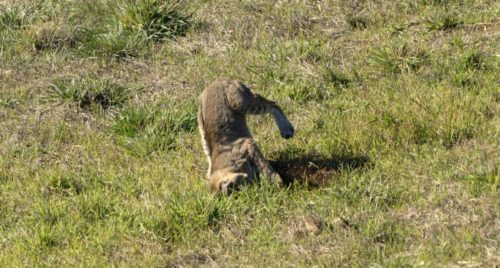
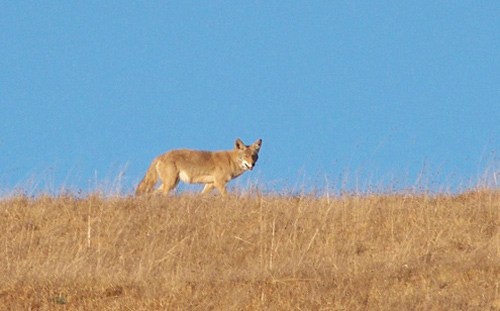

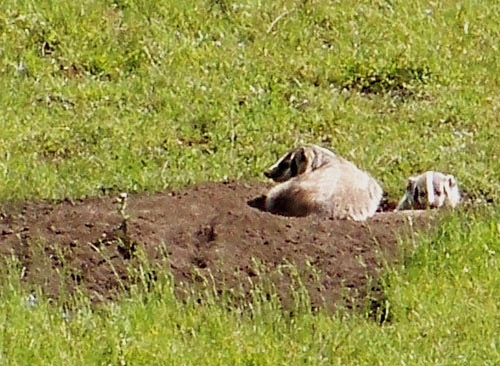

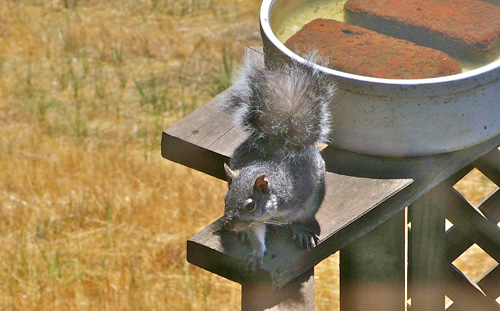
 The possums we see around here are Virginia Opossums, which are native to North America. Their lifespan is typically around four years. Possums are marsupials with counterparts found in Central and South America, New Zealand, and Australia.
The possums we see around here are Virginia Opossums, which are native to North America. Their lifespan is typically around four years. Possums are marsupials with counterparts found in Central and South America, New Zealand, and Australia.

